DrMario
0
- Joined
- Oct 19, 2013
- Messages
- 244
- Points
- 18
I am wondering about the Nikon D3400 DSLR camera's white balance settings regarding the beamshot of either nearly monochromatic LED flashlights and / or lasers; is it best to edit the white balance on the computer via RAW (NEF) file (Darktable on Linux computer - similar to Photoshop), or just mess with white balance settings on the camera itself?
Lastly, is it worth it going with Adobe color rendition or stick with sRGB? (Yeah, I know, I am beating a dead horse on that topic, but I just wanted to be sure so I don't waste my time and precious space on the SD card - faster SD cards aren't cheap, and my camera's apparently fussy about SD speed as far as HD camcorder mode and pure RAW capture are concerned.)
* I have been taking astrophotography for a while - here are a few examples below. However, I usually do RAW file editing on astrophotography images - is it safe to assume that the laser beamshots should be treated the same way as far as ISO and color balance on RAW files are concerned?
Lastly, is it worth it going with Adobe color rendition or stick with sRGB? (Yeah, I know, I am beating a dead horse on that topic, but I just wanted to be sure so I don't waste my time and precious space on the SD card - faster SD cards aren't cheap, and my camera's apparently fussy about SD speed as far as HD camcorder mode and pure RAW capture are concerned.)
* I have been taking astrophotography for a while - here are a few examples below. However, I usually do RAW file editing on astrophotography images - is it safe to assume that the laser beamshots should be treated the same way as far as ISO and color balance on RAW files are concerned?
Attachments
Last edited:






